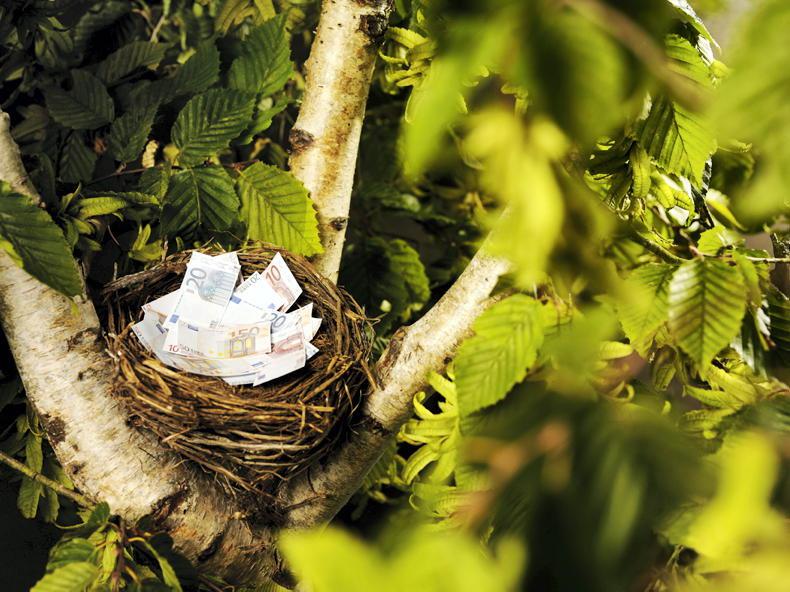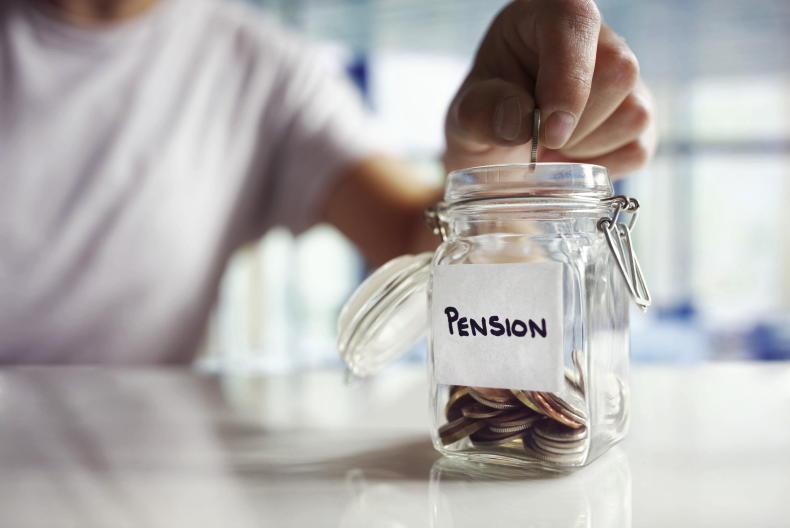This week, the Competition and Consumer Protection Commission (CCPC) said its own research has revealed concerning gaps in retirement planning. A CCPC survey showed that one in 10 45- to 64-year-olds do not have a pension, while the number aged between 45 and 54 with a pension has actually dropped in the last year.
Farmers don’t have an official retirement age unlike workers who are in employment and are paid a weekly or monthly wage.
Farmers will typically own their land and be self-employed sole traders and therefore have the option to work to whatever age they decide.
The exception to this is where farmers have a farm business, operating as a limited company. In this case, a farmer and family members may be directors or, in some cases, employees.
There are two types of pensions that can be available to citizens when they decide to retire.
State pensions
What is referred to as the State pension is available to all citizens who have made at least 10 years of PRSI contributions, or 520 units, as they are referred to.
Ten years’ contributions qualify to secure the minimum rate of retirement pension currently – €106 per week payable to people on reaching their 66th birthday. To qualify for the highest rate of State pension, €265.30 per week, 48 years of contributions are required.
See Table 1 for all rates payable depending on the number of years relating to PRSI contributions and the potential additional payments that may be available subject to means testing.
For employees, PRSI contributions are deducted at source with an additional contribution made by employers. However, as most farmers are self-employed, they are responsible for making PRSI payments in much the same way as they make income tax payments.
PRSI payments for employees start on income earned over €352 per week at a rate of 4% with a PRSI credit available on income between €352 and €424 per week.
Employers also contribute. Their rate is at 8.8% on weekly earnings up to €441 and 11.05% on wages above €441 per week.
PRSI contributions for self-employed people, including farmers, are paid under what is known as Class S PRSI contributions and while these cover the contributory State pensions and invalidity pension, notably they do not cover short-term illness payments. For self-employed Class S payments, 4% is payable on all income above €5,000 per annum, with a minimum payment of €500. For self-employed people earning less than €5,000 per annum, there is an option to make voluntary contributions up to €500.
Private pensions
While everyone is obliged to contribute to the State pension, private or voluntary pensions are available to people who have invested in private pension policies.
As the population ages, the Government is concerned that in the years to come, the State won’t be able to afford State pensions pro rata to the present rate. This is because more people will have reached pension age and qualify for the State pension, while fewer people will be working to generate the revenues necessary to pay.
Therefore, Government policy for several years has been to encourage people to “invest” in private pensions, which will serve as a top-up to State pensions. The form of encouragement is that the Government is giving full tax relief on payments made into a pension fund from income. This is particularly attractive to high-rate taxpayers who pay 40% tax on income above €40,000 or €49,000 for a married couple or civil partners as one income.
There is an upper limit of €115,000 annual income that qualifies for tax relief on pension contributions and there is also a wage-related scale for share of income that qualifies for tax allowance.
Anyone under 30 will get tax relief on up to 15% of their income into a pension fund. This increases with up to 40% of income qualifying for people aged 60 or over. For rates in the different age brackets in between, see Figure 1.

It is advised that professional advice is obtained before making any investments or decisions in relation to pensions.
For anyone who can afford to make pension contributions, these are one of the most tax-efficient savings schemes available. As well as the tax relief secured on contributions, up to 25% of the pension pot to a maximum value of €200,000 can be claimed as a tax-free lump sum after the age of 55.
An annuity is a regular income paid by the life insurance company that the fund is transferred to
In practice, people tend not to make a withdrawal until they are no longer making payments into the fund as it can only be done once and it makes sense to wait until the fund has reached its maximum value.
The options on retirement for the reminder of the fund are either purchasing an annuity or investing in an approved retirement fund (ARF).
An annuity is a regular income paid by the life insurance company that the fund is transferred to, and is calculated on the value of the fund plus age and health of the individual and interest rates.
An ARF is a personal retirement fund where the individual keeps the pension fund invested as a lump sum after retirement withdrawing money from it to provide an income.
In both of these cases, income becomes subject to taxation in the same way that the State pension is, once the tax-free threshold is reached.
These are basic pension principles. It is advised that professional advice is obtained before making any investments or decisions in relation to pensions.
This week, the Competition and Consumer Protection Commission (CCPC) said its own research has revealed concerning gaps in retirement planning. A CCPC survey showed that one in 10 45- to 64-year-olds do not have a pension, while the number aged between 45 and 54 with a pension has actually dropped in the last year.
Farmers don’t have an official retirement age unlike workers who are in employment and are paid a weekly or monthly wage.
Farmers will typically own their land and be self-employed sole traders and therefore have the option to work to whatever age they decide.
The exception to this is where farmers have a farm business, operating as a limited company. In this case, a farmer and family members may be directors or, in some cases, employees.
There are two types of pensions that can be available to citizens when they decide to retire.
State pensions
What is referred to as the State pension is available to all citizens who have made at least 10 years of PRSI contributions, or 520 units, as they are referred to.
Ten years’ contributions qualify to secure the minimum rate of retirement pension currently – €106 per week payable to people on reaching their 66th birthday. To qualify for the highest rate of State pension, €265.30 per week, 48 years of contributions are required.
See Table 1 for all rates payable depending on the number of years relating to PRSI contributions and the potential additional payments that may be available subject to means testing.
For employees, PRSI contributions are deducted at source with an additional contribution made by employers. However, as most farmers are self-employed, they are responsible for making PRSI payments in much the same way as they make income tax payments.
PRSI payments for employees start on income earned over €352 per week at a rate of 4% with a PRSI credit available on income between €352 and €424 per week.
Employers also contribute. Their rate is at 8.8% on weekly earnings up to €441 and 11.05% on wages above €441 per week.
PRSI contributions for self-employed people, including farmers, are paid under what is known as Class S PRSI contributions and while these cover the contributory State pensions and invalidity pension, notably they do not cover short-term illness payments. For self-employed Class S payments, 4% is payable on all income above €5,000 per annum, with a minimum payment of €500. For self-employed people earning less than €5,000 per annum, there is an option to make voluntary contributions up to €500.
Private pensions
While everyone is obliged to contribute to the State pension, private or voluntary pensions are available to people who have invested in private pension policies.
As the population ages, the Government is concerned that in the years to come, the State won’t be able to afford State pensions pro rata to the present rate. This is because more people will have reached pension age and qualify for the State pension, while fewer people will be working to generate the revenues necessary to pay.
Therefore, Government policy for several years has been to encourage people to “invest” in private pensions, which will serve as a top-up to State pensions. The form of encouragement is that the Government is giving full tax relief on payments made into a pension fund from income. This is particularly attractive to high-rate taxpayers who pay 40% tax on income above €40,000 or €49,000 for a married couple or civil partners as one income.
There is an upper limit of €115,000 annual income that qualifies for tax relief on pension contributions and there is also a wage-related scale for share of income that qualifies for tax allowance.
Anyone under 30 will get tax relief on up to 15% of their income into a pension fund. This increases with up to 40% of income qualifying for people aged 60 or over. For rates in the different age brackets in between, see Figure 1.

It is advised that professional advice is obtained before making any investments or decisions in relation to pensions.
For anyone who can afford to make pension contributions, these are one of the most tax-efficient savings schemes available. As well as the tax relief secured on contributions, up to 25% of the pension pot to a maximum value of €200,000 can be claimed as a tax-free lump sum after the age of 55.
An annuity is a regular income paid by the life insurance company that the fund is transferred to
In practice, people tend not to make a withdrawal until they are no longer making payments into the fund as it can only be done once and it makes sense to wait until the fund has reached its maximum value.
The options on retirement for the reminder of the fund are either purchasing an annuity or investing in an approved retirement fund (ARF).
An annuity is a regular income paid by the life insurance company that the fund is transferred to, and is calculated on the value of the fund plus age and health of the individual and interest rates.
An ARF is a personal retirement fund where the individual keeps the pension fund invested as a lump sum after retirement withdrawing money from it to provide an income.
In both of these cases, income becomes subject to taxation in the same way that the State pension is, once the tax-free threshold is reached.
These are basic pension principles. It is advised that professional advice is obtained before making any investments or decisions in relation to pensions.







 This is a subscriber-only article
This is a subscriber-only article










SHARING OPTIONS: